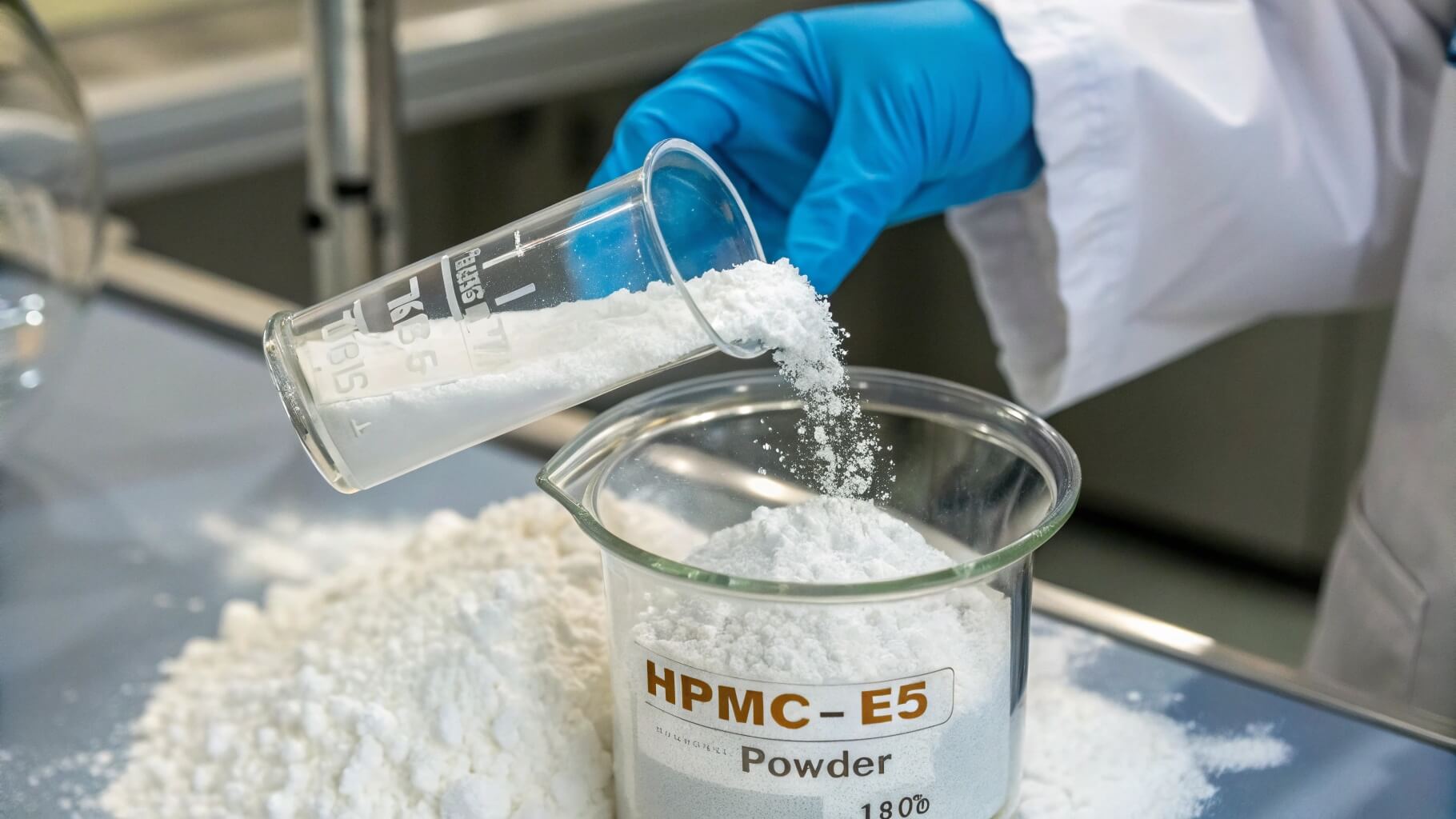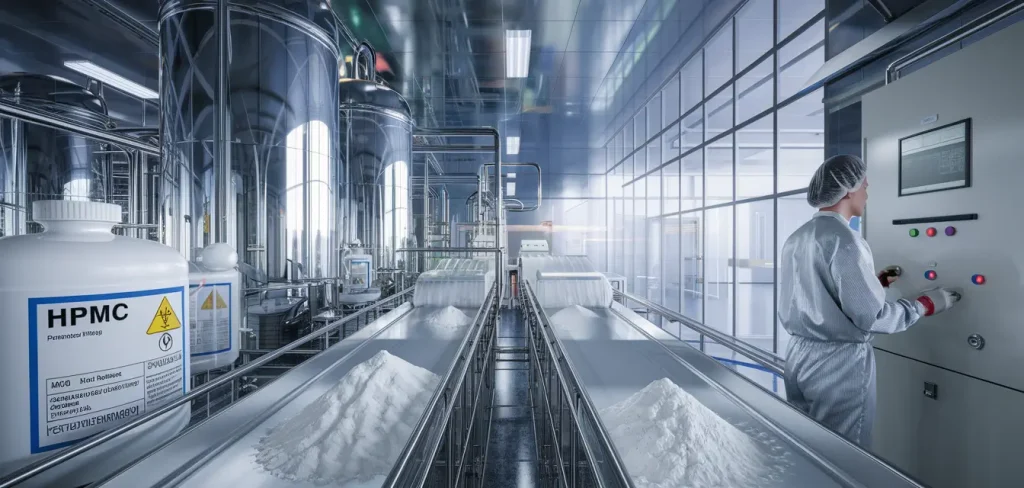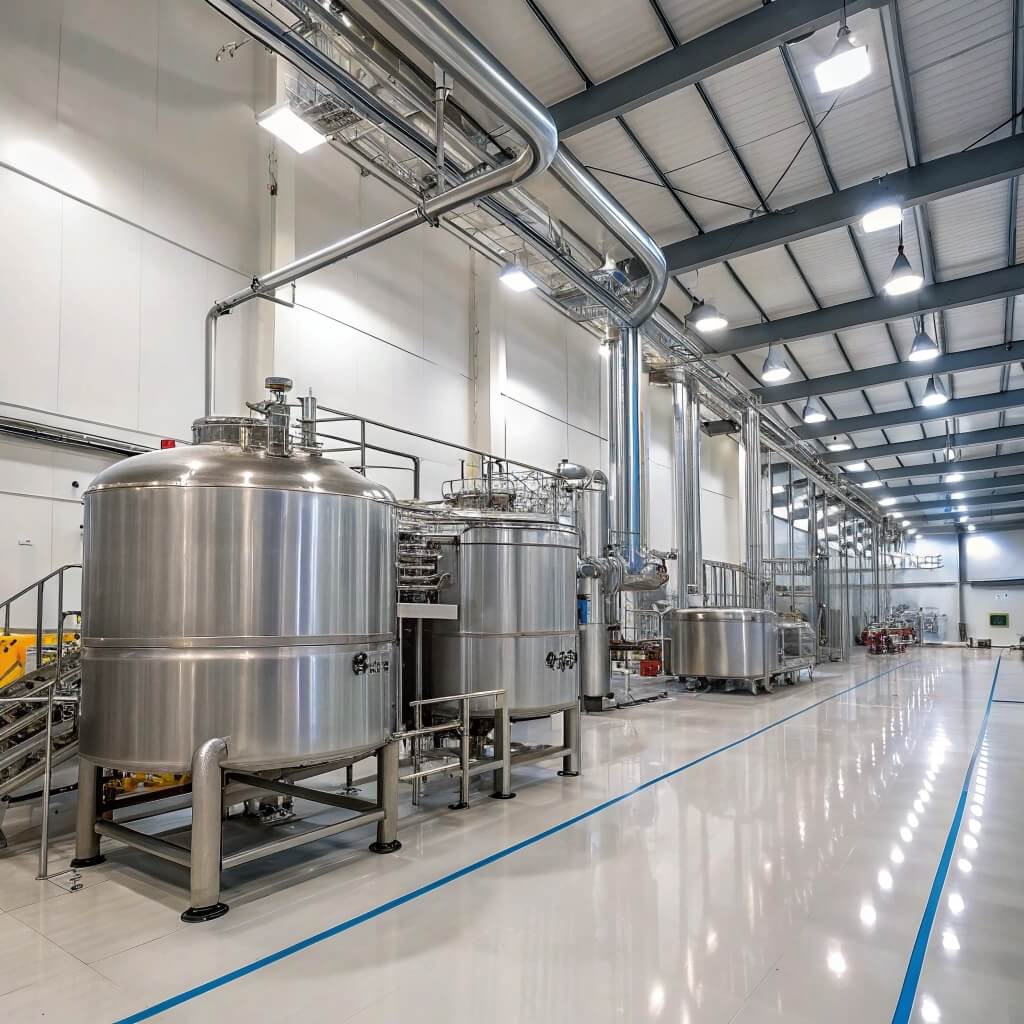HPMC E15 is widely used in pharmaceuticals, construction, and food applications, but its solubility determines its performance in each industry. If it dissolves inconsistently, it can lead to formulation failures, inefficient drug delivery, or poor binding properties.
Hydroxypropylméthylcellulose (HPMC) E15 is soluble in water and certain organic solvents. Its solubility depends on factors like temperature, pH, and polymer substitution level. Proper dissolution methods ensure uniform viscosity and stability, which is essential for industries requiring precise formulation control.

Illustration of HPMC E15 dissolving in water, showing its dispersion and viscosity development.
Compréhension how HPMC E15 dissolves and the factors affecting its solubility is crucial for optimizing its performance in different applications. Let’s explore its solubility characteristics, influencing factors, and methods to enhance its dissolution.
What Is HPMC E15 and Why Does Solubility Matter?
Hydroxypropyl Methylcellulose (HPMC) E15 is a versatile polymer used in pharmaceuticals, construction, and food industries. But what makes its solubility so important? If not properly dissolved, it can cause formulation failures, poor performance, or inefficiencies dans diverses applications.
HPMC E15 est un water-soluble cellulose ether with moderate viscosity and controlled hydration properties. Its solubility is crucial for its functionality in drug delivery, coatings, adhesives, and thickening agents. The ability to dissolve effectively ensures consistency in product performance across industries.
What Is HPMC E15?
HPMC E15 is a specific grade of hydroxypropyl methylcellulose known for its low-to-medium viscosity (15 mPa·s in 2% aqueous solution) and high purity. It is commonly used in:
- Médicaments: Controlled drug release, tablet binding, and film coating.
- Construction: Improving water retention and workability in cement-based materials.
- Nourriture: Acting as a stabilizer and emulsifier in food formulations.
- Soins personnels: Enhancing texture and consistency in cosmetics and skincare products.
This polymer dissolves in cold water and certain organic solvents, forming a clear, stable solution with excellent film-forming and thickening properties.
Why Does Solubility Matter?
Le solubility of HPMC E15 directly affects its application efficiency in different industries. Poor solubility leads to inconsistent formulations, reduced performance, and operational inefficiencies. Here’s why solubility is crucial:
-
Industrie pharmaceutique:
- Influences drug release rates in sustained-release tablets.
- Assure even distribution in oral suspensions and ophthalmic solutions.
- Améliore film coating adhesion and integrity.
-
Secteur de la construction:
- Améliore water retention in cement-based materials, preventing cracks.
- Améliore maniabilité et étalabilité in tile adhesives and plasters.
- Prevents lump formation, ensuring smooth mixing in dry mortar.
-
Industrie alimentaire:
- Acts as a épaississant et stabilisant in plant-based dairy alternatives.
- Améliore texture and shelf stability in sauces and dressings.
- Fournit controlled viscosity in beverages and emulsions.
-
Cosmétiques et soins personnels:
- Assure smooth dispersion in creams and lotions.
- Améliore film-forming properties in hair and skincare products.
- Empêche separation in liquid formulations.
Key Properties Influencing Solubility
Several characteristics determine how well HPMC E15 dissolves in different solvents:
- Sensibilité à la température: Soluble in cold water but forms gels at higher temperatures.
- Taille des particules: Finer powders dissolve faster and more uniformly.
- Substitution Level: Higher hydroxypropyl content increases organic solvent solubility.
- Plage de pH: Stable across a wide pH range, but extreme conditions may affect solubility.
Le correct dissolution method et optimized formulation techniques ensure that HPMC E15 performs effectively in each application.
HPMC E15’s solubility defines its role in industrial and pharmaceutical formulations. But how exactly does it dissolve in water and other solvents? Let's break down the dissolution process in the next section.
How Does HPMC E15 Dissolve in Water and Other Solvents?
HPMC E15 is widely used in industries where controlled viscosity, stability, and film-forming properties are critical. But improper dissolution[^1] can lead to clumping, uneven dispersion, or inefficient performance dans les formulations.
[^1]: Learn how improper dissolution can impact your formulations and discover solutions to avoid these issues.
HPMC E15 dissolves in cold water and certain organic solvents through a hydration and dispersion process. It forms a colloidal solution, providing thickening, stabilization, and film-forming properties essential for pharmaceuticals, construction, and food applications.
Dissolution Process in Water
HPMC E15 est cold-water soluble, meaning it disperses and hydrates at lower temperatures. The dissolution follows a three-phase process:
-
Dispersion Stage
- HPMC E15 powder is slowly added to cold water under continuous stirring.
- Fine particles disperse throughout the liquid without immediate dissolution.
- Proper stirring prevents agglomeration or gel formation.
-
Hydration and Swelling
- The polymer absorbs water and swells, forming a hydrated layer around each particle.
- Stirring at moderate speeds allows gradual water penetration, softening the particles.
-
Complete Dissolution
- Once fully hydrated, HPMC E15 dissolves into a clear, homogeneous solution.
- The viscosity develops over time, depending on concentration and temperature.
Effect of Temperature on Solubility
-
Cold Water (Below 40°C / 104°F):
- HPMC E15 fully dissolves with proper stirring.
- Viscosity develops gradually, ensuring even distribution.
-
Hot Water (Above 60°C / 140°F):
- The polymer gelates instead of dissolving, forming a thick, jelly-like structure.
- This property is used in controlled drug release and thermal gelling applications.
Solubility in Organic Solvents
HPMC E15 est partially soluble in some organic solvents but fully soluble in aqueous-organic mixtures. Its solubility depends on the hydroxypropyl substitution level:
| Type de solvant | Comportement de solubilité |
|---|---|
| Cold Water | Fully soluble |
| Ethanol, Methanol | Poor solubility |
| Isopropanol | Limited solubility |
| Acétone, chloroforme | Insoluble |
| Water-Alcohol Mix | Partially to fully soluble, depending on concentration |
In pharmaceutical and coatings applications, water-alcohol mixtures (e.g., ethanol + water) are used to enhance solubility and improve film formation.
Common Dissolution Problems and Solutions
1. Clumping and Agglomeration
- Cause: Adding HPMC E15 too quickly without proper stirring.
- Solution: Gradual addition with continuous stirring prevents clumps.
2. Incomplete Dissolution
- Cause: Inadequate hydration time.
- Solution: Allow full swelling before increasing mixing speed.
3. Gel Formation in Hot Water
- Cause: Direct addition to hot water above 60°C.
- Solution: Disperse in cold water first, then heat gradually if needed.
Compréhension how to properly dissolve HPMC E15 ensures optimal performance in formulations. But what external factors influence its solubility? Let's examine the key factors in the next section.
Quels facteurs affectent la solubilité du HPMC E15 ?
HPMC E15 plays a crucial role in industries requiring controlled viscosity, stability, and dispersion. However, if solubility is inconsistent, it can lead to formulation defects, improper thickening, or phase separation in applications like pharmaceuticals, construction, and food.
The solubility of HPMC E15 depends on multiple factors, including temperature, pH, particle size, substitution degree, and mixing techniques. Understanding these elements ensures optimal dissolution and performance in formulations.
1. Temperature Sensitivity
HPMC E15 présente unique thermal gelation properties, meaning it behaves differently in cold and hot water:
- Cold Water (Below 40°C / 104°F): Fully dissolves, forming a stable, viscous solution.
- Warm Water (40°C–60°C / 104°F–140°F): Partial hydration occurs, but full solubility is delayed.
- Hot Water (Above 60°C / 140°F): Gelation occurs instead of dissolution, causing phase separation.
Solution: Always dissolve HPMC E15 in cold water first, ensuring even dispersion before increasing the temperature.
2. pH Level and Ionic Strength
HPMC E15 remains stable over a broad pH range (3–11) but may exhibit slight solubility variations:
- Acidic Conditions (pH < 3): Reduced hydration rate; prolonged dissolution time.
- Neutral to Slightly Alkaline (pH 6–9): Ideal solubility conditions.
- Highly Alkaline (pH > 11): May reduce polymer stability over time.
Solution: Maintain a pH range between 6 and 9 to achieve optimal solubility and stability.
3. Particle Size and Surface Area
Le fineness of HPMC E15 powder directly influences its solubility rate:
| Taille des particules | Vitesse de dissolution | Application Suitability |
|---|---|---|
| Fine Powder (<100 μm) | Fastest dissolution | Ideal for rapid dispersion in liquids |
| Medium Powder (100–300 μm) | Moderate dissolution | Suitable for controlled-release formulations |
| Coarse Powder (>300 μm) | Slow dissolution | Used in delayed-release drug coatings |
Solution: Choose a finer powder for applications requiring fast dissolution, such as liquid suspensions or instant thickening.
4. Hydroxypropyl Substitution Level
Le degree of hydroxypropyl substitution (DS value) affects solubility in both water and organic solvents:
- Higher DS Value: Improved solubility in water-alcohol mixtures (e.g., ethanol + water).
- Lower DS Value: Higher water solubility but reduced organic solvent compatibility.
Solution: Select HPMC E15 with the appropriate DS level based on whether the formulation requires water-only or mixed-solvent solubility.
5. Mixing and Hydration Techniques
Incorrect mixing methods can cause clumping, phase separation, or inconsistent viscosity developmentLes meilleures pratiques comprennent :
- Slow Addition: Gradually sprinkle HPMC E15 into cold water while stirring.
- Continuous Agitation: Maintain gentle mixing until full hydration occurs.
- Pre-Dissolution Methods: For high concentrations, pre-dissolve HPMC in a small amount of water before adding it to the final batch.
6. Presence of Electrolytes and Additives
Salts, surfactants, and co-solvents can enhance or hinder solubility:
- Electrolytes (e.g., NaCl, CaCl₂): Can reduce viscosity by disrupting polymer interactions.
- Surfactants (e.g., Polysorbates): Improve wetting and dispersion in hydrophobic formulations.
- Co-Solvents (e.g., Propylene Glycol): Modify dissolution rates in pharmaceutical and cosmetic applications.
Solution: Adjust formulations carefully to balance viscosity, stability, and solubility.
Solubility plays a key role in optimizing HPMC E15’s performance. But how can it be enhanced to achieve faster dissolution and better dispersion? Let’s explore effective solubility enhancement techniques in the next section.
How to Enhance the Solubility and Dissolution Rate of HPMC E15?
HPMC E15 is widely used in pharmaceuticals, construction, and food applications, but slow dissolution and poor dispersion peut conduire à clumping, inconsistent viscosity, and inefficient formulations. To maximize its functionality, proper solubility enhancement techniques must be applied.
Le solubility and dissolution rate of HPMC E15 can be improved by optimizing dispersion methods, adjusting temperature, using pre-hydration techniques, and incorporating surfactants or co-solvents. These strategies ensure efficient hydration, smooth viscosity development, and uniform performance dans les formulations.
1. Use Proper Dispersion Techniques
Incorrect dispersion often leads to clumping and incomplete hydration. The best practices for uniform dispersion include:
- Gradual Addition: Sprinkle HPMC E15 powder slowly into water tout en remuant.
- Continuous Agitation: Maintenir gentle but consistent mixing to prevent agglomeration.
- Pre-Wetting with Organic Solvents: For formulations requiring rapid dispersion, first wet the powder with a water-miscible organic solvent (e.g., ethanol, propylene glycol), then add water.
2. Control Water Temperature for Optimal Hydration
HPMC E15 présente thermal gelation properties, meaning temperature affects its dissolution:
| Température de l'eau | Effet sur HPMC E15 | Recommended Action |
|---|---|---|
| Cold (<40°C / 104°F) | Fully dissolves with proper stirring | Preferred temperature range for hydration |
| Warm (40–60°C / 104–140°F) | Slower dissolution due to partial swelling | Allow more time for hydration |
| Hot (>60°C / 140°F) | Gel formation instead of dissolution | Avoid direct addition to hot water |
Best Practice: Toujours disperse HPMC E15 in cold water first, then gradually increase the temperature if necessary.
3. Adjust pH Levels for Faster Solubility
HPMC E15 remains stable between pH 3–11, but extreme conditions can affect solubility:
- Optimal pH for Dissolution: 6.0–9.0 assure efficient hydration.
- Acidic Conditions (pH < 3): Slows down hydration; may require longer mixing times.
- Highly Alkaline Conditions (pH > 11): Can weaken polymer structure over time.
Solution: If faster dissolution is required, adjust the pH to a neutral range before adding HPMC E15.
4. Reduce Particle Size for Faster Hydration
Finer HPMC E15 particles dissolve more quickly and uniformly compared to coarser grades:
| Taille des particules | Vitesse de dissolution | Utilisation recommandée |
|---|---|---|
| Fine (<100 μm) | Fastest | Rapid dispersion in aqueous formulations |
| Medium (100–300 μm) | Modéré | Standard thickening applications |
| Coarse (>300 μm) | Slowest | Controlled-release coatings |
Solution: Utiliser micronized or finely milled HPMC E15 for applications requiring rapid solubility.
5. Pre-Hydration and Slurry Techniques
For large-scale industrial formulations, pre-hydration methods prevent incomplete dissolution:
- Dry Pre-Mix Method: Blend HPMC E15 with other dry ingredients before adding liquid to improve wetting.
- Slurry Method: Disperse HPMC E15 in a small amount of non-solvent liquid (e.g., ethanol or glycerol) before introducing water.
- Stepwise Hydration: Add HPMC E15 to 80% of the total water volume, stir, then slowly introduce the remaining liquid.
6. Incorporate Surfactants or Co-Solvents
Surfactants and co-solvents enhance wetting, dispersion, and solubility in complex formulations:
| Additive Type | Effect on HPMC E15 Solubility | Example Additives |
|---|---|---|
| tensioactifs | Improves wetting, prevents clumping | Polysorbates, Sodium Lauryl Sulfate |
| Co-Solvents | Enhances solubility in organic-aqueous systems | Ethanol, Propylene Glycol |
| Electrolytes | Modifies viscosity for controlled release | Sodium Chloride, Calcium Chloride |
Best Practice: Select additives compatible with the final formulation to avoid unwanted interactions.
7. Optimize Mixing Speed and Equipment
Shear forces play a critical role in breaking up particles and accelerating hydration:
- Low-Speed Mixing (300–500 rpm): Convient pour pharmaceutical suspensions.
- Medium-Speed Mixing (500–1000 rpm): Ideal for food and cosmetic emulsions.
- High-Shear Mixing (>1000 rpm): Obligatoire pour construction materials and industrial coatings.
Solution: Choose mixing speeds based on viscosity requirements, ensuring complete hydration without over-shearing.
Enhancing HPMC E15’s solubility leads to better formulation stability, improved performance, and process efficiency. But how does this impact different industries? The next section explores its practical applications across various fields.
What Are the Practical Implications of HPMC E15 Solubility in Various Industries?
HPMC E15’s solubility is a critical factor influencing its effectiveness in pharmaceuticals, construction, food, and cosmetics. If it dissolves poorly, drug formulations may fail, construction materials may lose adhesion, and food products may separate.
Compréhension how solubility impacts industry-specific applications helps manufacturers optimize formulations, ensuring consistent performance, enhanced stability, and cost efficiency.
1. Pharmaceutical Industry: Controlled Drug Release and Bioavailability
Le HPMC E15 est largement utilisé dans oral solid dosage forms, y compris tablet coatings, controlled-release drugs, and suspensions. Its solubility affects:
- Drug Dissolution Rate: Proper solubility ensures predictable drug release in extended-release tablets.
- Film Coating Uniformity: Améliore adhesion and moisture protection in tablet coatings.
- Suspension Stability: Empêche particle settling in liquid medications.
| Pharmaceutical Application | Impact of Solubility | Optimization Strategies |
|---|---|---|
| Extended-Release Tablets | Contrôle le taux de libération du médicament | Adjust hydration time, pH, and particle size |
| Revêtements de film | Ensures smooth, even film | Use water-alcohol solvent blends |
| Oral Suspensions | Prevents sedimentation | Optimize mixing speed and viscosity |
Key Takeaway: Proper solubility enhances drug bioavailability and stability, assurant regulatory compliance and patient safety.
2. Construction Industry: Water Retention and Adhesion Strength
In cement-based applications, HPMC E15’s solubility influences workability, water retention, and adhesion. Poor solubility leads to lump formation, uneven hydration, and loss of strength.
- Tile Adhesives: Améliore bonding and open time, ensuring better adhesion.
- Self-Leveling Compounds: Fournit smooth application and uniform curing.
- Plasters & Renders: Améliore rétention d'eau, reducing cracks and shrinkage.
| Demande de permis de construire | Role of HPMC E15 Solubility | Optimization Methods |
|---|---|---|
| Adhésifs pour carrelage | Increases open time, improves adhesion | Pre-mix in dry blends |
| Cement Mortars | Enhances water retention | Dissolve in cold water first |
| Composés autonivelants | Ensures smooth flow and spreadability | Use fine-particle HPMC E15 |
Key Takeaway: Proper solubility improves application quality, durability, and work efficiency, réduisant material waste and labor costs.
3. Food Industry: Thickening and Stabilization in Processed Foods
HPMC E15 acts as a stabilisant, épaississant et émulsifiant in food products. If solubility is poor, it can cause lumps, phase separation, and inconsistent textures.
- Dairy Alternatives (e.g., plant-based milk): Fournit creamy texture and suspension stability.
- Sauces & Dressings: Empêche oil-water separation.
- Bakery & Gluten-Free Products: Améliore dough elasticity and moisture retention.
| Food Application | Effect of HPMC E15 Solubility | Meilleures pratiques |
|---|---|---|
| Plant-Based Milk | Ensures uniform suspension | Disperse in cold liquid first |
| Sauces & Dressings | Prevents separation | Use surfactants for better dispersion |
| Gluten-Free Dough | Enhances elasticity | Hydrate fully before mixing |
Key Takeaway: Proper dissolution ensures smooth texture, extended shelf life, and consumer satisfaction in food applications.
4. Cosmetics and Personal Care: Texture and Stability in Formulations
HPMC E15 est utilisé dans lotions, creams, and hair care products pour texture enhancement, viscosity control, and moisture retention.
- Skin Creams & Lotions: Empêche ingredient separation and improves skin feel.
- Hair Styling Gels: Fournit film-forming properties for hold and texture.
- Facial Masks: Améliore hydration and adhesion for even application.
| Cosmetic Application | Solubility Impact | Recommended Method |
|---|---|---|
| Skin Creams | Prevents phase separation | Use pre-hydration techniques |
| Hair Gels | Améliore les propriétés filmogènes | Adjust pH for faster solubility |
| Facial Masks | Ensures even texture | Optimize particle size |
Key Takeaway: Proper solubility ensures product stability, enhanced skin feel, and improved consumer experience.
Maximizing the Benefits of HPMC E15 Through Solubility Optimization
The ability of HPMC E15 to fully dissolve and integrate into formulations directly affects product performance, manufacturing efficiency, and cost-effectiveness. By applying the right dissolution techniques, industries can achieve optimal results in pharmaceuticals, construction, food, and cosmetics.
Comprendre le practical implications of solubility across industries highlights why proper dissolution techniques matter. But what are the key takeaways from everything we’ve discussed? Let’s summarize in the final section.
Conclusion
The solubility of HPMC E15 plays a defining role in its effectiveness across industries. Whether used in pharmaceuticals, construction, food, or cosmetics, proper dissolution techniques ensure consistent performance, stability, and process efficiency. Factors such as temperature, pH, particle size, and mixing techniques all influence its solubility, making optimization essential.
By applying controlled hydration, dispersion techniques, and appropriate solvent systems, manufacturers can prevent clumping, phase separation, or incomplete dissolution. Cela conduit à better drug bioavailability, improved workability in construction, enhanced texture in food, and stable formulations in personal care products. Understanding how to manipulate these variables allows industries to maximize product quality while minimizing processing challenges.
For businesses dealing with HPMC E15 formulation and application, choosing the right dissolution strategy can enhance operational efficiency. If you’re looking to optimize HPMC E15 solubility for your specific industry needs, exploring advanced formulation techniques or collaborating with technical experts can help refine your process.
FAQ
Le HPMC E15 est-il soluble dans l'eau ?
Oui, HPMC E15 est soluble in cold water, forming a clear and stable solution. However, it does not dissolve in hot water above 60°C (140°F) but instead forms a gel-like structure. The best way to dissolve it is by gradually adding it to cold water with continuous stirring to prevent clumping. Proper hydration ensures even viscosity development, ce qui le rend adapté à pharmaceutical, construction, food, and cosmetic applications.
What is HPMC soluble in?
HPMC est highly soluble in cold water et partially soluble in some organic solvents, depending on its hydroxypropyl substitution level. It dissolves well in water-alcohol mixtures (e.g., ethanol-water solutions) and certain glycols (e.g., propylene glycol). However, it is insoluble in pure ethanol, acetone, and chloroform. Le dissolution process depends on factors like temperature, pH, and mixing method, ensuring it fully disperses in formulations.
Quelle est la différence entre HPMC E5 et E15 ?
La principale différence entre HPMC E5 et E15 is their viscosité in aqueous solutions:
| Grade | Viscosity (2% Solution, mPa·s) | Applications courantes |
|---|---|---|
| HPMC E5 | 4-6 mPa·s | Utilisé dans film coatings, spray drying, and low-viscosity suspensions |
| HPMC E15 | 13-18 mPa·s | Utilisé dans controlled-release formulations, adhesives, and moderate-thickening applications |
HPMC E15 has viscosité plus élevée than E5, making it more suitable for sustained-release drugs, construction materials, and food stabilizers, whereas E5 is preferred for fast-dissolving coatings and liquid formulations.
Comment solubiliser l'HPMC ?
To properly dissolve HPMC, follow these steps:
- Use Cold Water: HPMC dissolves best in water below 40°C (104°F). Avoid direct addition to hot water.
- Gradually Add Powder: Sprinkle HPMC slowly into water while stirring to prevent clumping.
- Ensure Continuous Stirring: Use gentle agitation to allow full hydration and viscosity development.
- Allow Hydration Time: Depending on concentration and particle size, full solubility may take 30–60 minutes.
- Pre-Wetting for Faster Dispersion: If needed, disperse HPMC in a small amount of ethanol or glycerol before adding water to improve solubility.
By using proper hydration and dispersion techniques, HPMC dissolves efficiently, ensuring consistent performance in pharmaceuticals, construction, food, and cosmetics.




